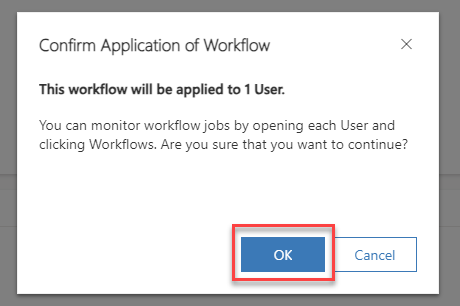Service Layout
Starting with the release 6.5, the use of b+s Connects for Dynamics with Cisco Webex Contact Centers is deprecated.
Instead, please use the 'Cisco Webex Contact Center' integration from Cisco for new deployments.
Service Layouts manage the Agent Desktop (Gadget) behavior such as what records should be queried in Dynamics 365 to identify a caller, or how phone numbers should to be translated.
Step 1: Navigate to b+s Connects for Cisco Contact Center.
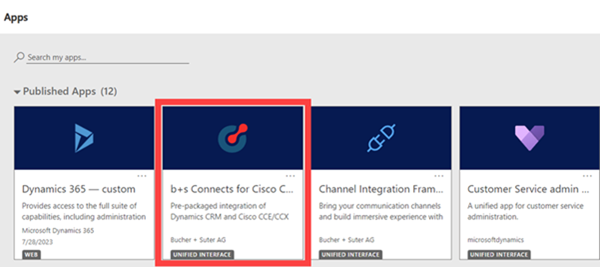
Step 2: Open a Service Layout.
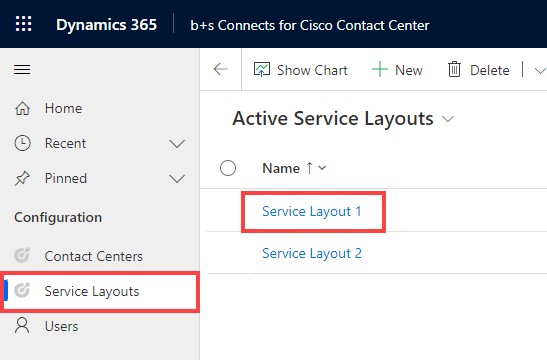
Step 3: Display the form for WxCC.
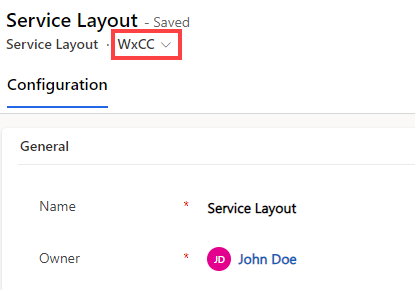
Settings
Step 1: Provide a Name. This name will be displayed in any related record.
Step 2: Provide these settings:
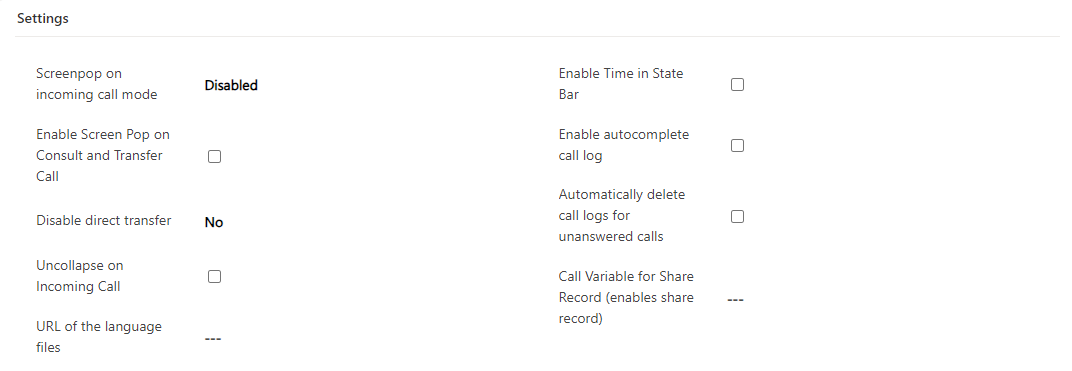
| Setting | Description |
|---|---|
Screen pop on incoming call mode | Disables or sets the available screen pop mode for incoming calls. More information can be found here. |
Enable Time in State Bar | Enables or disables the agent state timers. |
Enable Screen Pop on Consult and Transfer Call | Enables or disables the screen pop on consult and transfer calls. |
Enable autocomplete call log | Enables or disables automatic completion of the phone call log after the call ends. This corresponds to the "Mark Complete" menu item for a phone call record. |
Disable direct transfer | Enables or disables the function to directly transfer a phone call to another agent. |
Automatically delete call logs for unanswered calls | Enables or Disables automatic deletion of phone call logs for calls that haven't been answered by the agent (e.g. RONA) |
Uncollapse on Incoming Call | Enables or disables an automatic uncollapse for an incoming call. |
Call Variable for Share Record | Mandatory setting! Defines the name of the call variable to share a record (e.g callVar1). In order to have consistent phone call log handling, share record must be enabled. If undefined, share record will be disabled. |
URL of the language files | Defines the URL of the translation files for the languages. It must contain the placeholder {{locale}} for the language code ID.More information can be found here. |
Screen pop on incoming call mode
The following options are available:
| Setting | Description |
|---|---|
| Disabled | No record will be opened. |
| Activity | The phone call log will be opened. More information can be found here |
| Participant | A participant lookup will be done. If there's only one result the found record will be opened. More information can be found here |
| Case | A new case with the configured data pre-filled will be opened. More information can be found here |
Language Files
Step 1: Download the example language file.
Step 2: Change the locale in the file name to the BCP 47 code and change file extension to *.js.
Example:
bsconnects_language_de-DE.js.
Step 3: Change the values in the language file.
Step 4: Upload the file to Microsoft Dynamics and get it's URL. More information can be found here.
Step 5: Enter the URL in the field URL of the language files.
Example:
https://<yourorg>.crm<num>.dynamics.com/WebResources/<prefix>bsconnects_language_de-DE.js
Step 6: Remove the BCP 47 code in the URL.
Example:
https://<yourorg>.crm<num>.dynamics.com/WebResources/<prefix>bsconnects_language_de-DE.js
Step 7: Add the {{locale}} placeholder in place of the BCP 47 code.
Example:
https://<yourorg>.crm<num>.dynamics.com/WebResources/<prefix>bsconnects_language_{{locale}}.js

The gadget will get translated only if the uploaded language file matches the current crm language.
To learn how to configure your crm language go here.
Click-to-dial
The section click-to-dial allows the administrator to configure multiple dialing rules which are applied to the number stored in the CRM.

| Field | Description |
|---|---|
| Description | Descriptive name for the rule |
| Translation Rule | Please refer to Phone Number Translations for more information on the Translation Rule. |
To enable a non-standard field for click-to-dial, please refer to System Configuration
Set the phone number as the name on a phone call
When you use click-to-dial on a phone call record, the displayed name on the phone call will be the title by default (e.g. Call - 2020-11-16T16:13:30.079Z).
To display the phone number instead go to the Lookup Layout and add a configuration entry for the phonecall entity:
| Entity | Name | Subtitle1 | Subtitle2 | Home | Mobile | Work |
|---|---|---|---|---|---|---|
| phonecall | phonenumber | - | - | - | - | - |
Directory Lookup
The directory lookup uses the input of the dialing field and searches in the configured fields of a Microsoft Dynamics entity. You can set filter rules on Microsoft Dynamics selected entities by using OData filters syntax.
The found results are shown with the name and the telephone numbers for home, mobile and work. The corresponding fields are configured in the lookup layout configuration.
Directory numbers can also be included in the search. For a full description refer to Directory Number.
Entity lookup settings
Step 1: Provide these settings:
| Setting | Description |
|---|---|
Min. length of characters to search | Sets the minimal length of characters that must be entered to start the search. Default: 2 |
Delay between typing and searching | Sets the delay in milliseconds after typing to start the search. Default: 300 |
Step 2: Select an entity from the dropdown field. The provided options are the logical names of the entities.
Step 3: Insert a filter rule. Use OData syntax for filters and apply one or more lookup parameters to it.
For more information about OData filters please visit: http://docs.oasis-open.org/odata/odata/v4.01/cs01/part2-url-conventions/odata-v4.01-cs01-part2-url-conventions.html#_Toc505773218
The lookup parameter for the entered string is '{searchText}'
Example:
If you would like to search for the entered text in the fields "telephone1" and "fullname", the rule should be:
contains(fullname, '{searchText}') or contains(telephone1, '{searchText}')
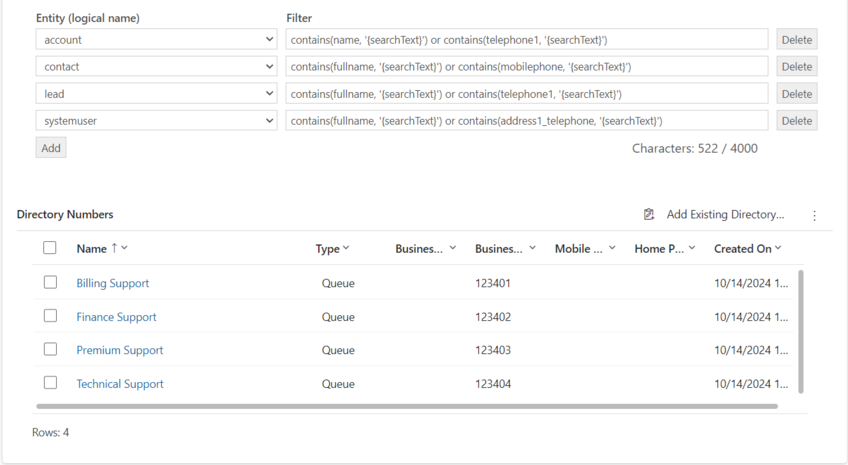
Directory numbers
Step 1: Click on Add Existing Directory Numbers.

Step 2: Search for and select the desired Directory Numbers.
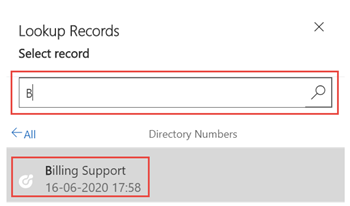
Step 3: Click Add.
The lookup results are limited to 30 directory numbers.
Refer to Directory Number for more information.
Participant Lookup
If BAAccountNumber is available and referenced in the participant lookup, rules without {BAAccountNumber} will not be used for the lookup.
Step 1: Set rules to adjust the phone number (ANI) for the lookup in the crm.
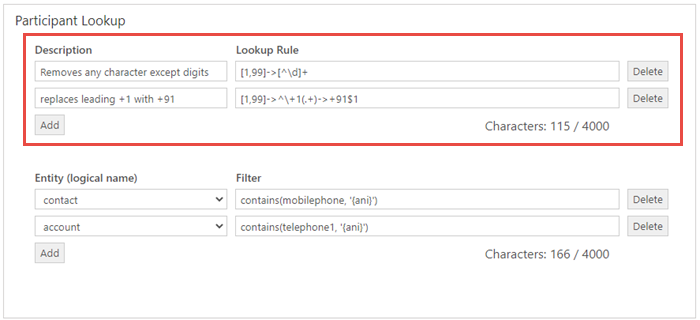
| Field | Description |
|---|---|
| Description | Descriptive name for the rule. |
| Translation Rule | Please refer to Phone Number Translations for more information on the Translation Rule. |
Step 2: Select an entity from the dropdown field and enter a filter rule.
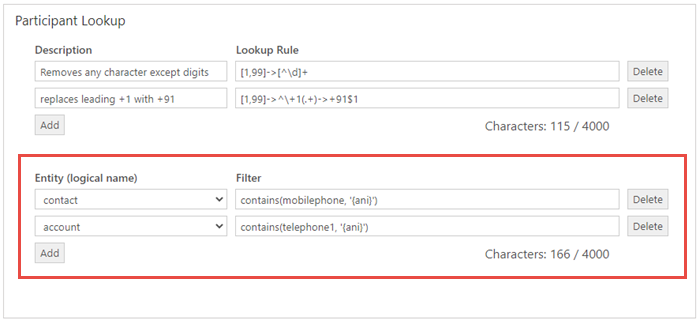
| Field | Description |
|---|---|
| Entity | The provided options are the logical names of the entities. |
| Filter | Use OData syntax for filters and apply one or more lookup parameters to them. |
For more information about OData filters please visit: http://docs.oasis-open.org/odata/odata/v4.01/cs01/part2-url-conventions/odata-v4.01-cs01-part2-url-conventions.html#_Toc505773218
Available lookup parameters are:
{ani}: Automatic Number Identification{callVar}: The content of a call variable
Each field of an entity has a type (e.g string, guid). Please make sure that for string attributes the lookup parameter is surrounded by an apostrophe ('), and for non-string attributes (e.g. accountid) no apostrophes are used.
For string attributes the value empty is used if the variable contains no data and for non-string attributes the value null is used.
Examples:
| Rule | Description |
|---|---|
telephone1 eq '{ani}' | telephone1 is equal to ani |
telephone1 eq '{ani}' or telephone1 eq '{callVar}' | telephone1 is equal to ani or callVar |
mobilephone eq '{ani}' and contactid ne {callVar} | mobilephone is equal to ani and contactid not equal to the callVar |
contains(telephone1, '{callVar}') | telephone1 contains callVar |
Lookup Layout
Each row in the Lookup Layout defines which fields of a CRM record are mapped to which part of the UI, you can add and remove entries for each entity type.

The following graphics depict how and where the fields will be shown on the b+s Connects for Microsoft Dynamics gadget. If Subtitle1 and Subtitle2 are not configured the entity name will be displayed - e.g. contact, account, lead.
Click-to-dial and participant lookup:
Directory lookup:
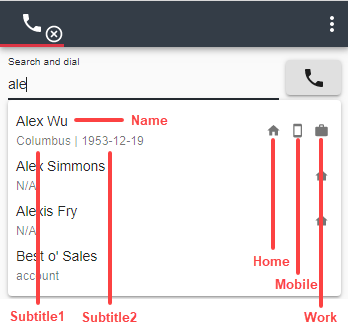
Create new record links
Links are shown on the Create tab and can either point to a target within the CRM or to an external URI.
Step 1: Go to the Create new record links section.

Step 2: Add a new entry.
Each entry consists of a Link Name and corresponding data (Form data or URI).
Link Name is the text shown on the user interface, it should help the agent pick the right "create action" during a call. The create tab is hidden on the user interface when there are no links configured.
For links pointing to a CRM resource: right column defines the entity to open and the fields which should be pre-filled with values. Further information can be found in chapter Links pointing to CRM records.
For external links: right column contains the URI. Further information can be found in chapter Links pointing to external URIs.
Links pointing to CRM records
This field has the following format:
entity=<LogicalName>&<Attribute1>={<Data>}
LogicalName: Dynamics 365 entity logical name.
AttributeN: Attribute of the entity which should be prepopulated with data.
Data: Information retrieved from the current call or from the participant lookup if there's exactly one match.
Examples:
| Form data or URI | Description |
|---|---|
entity=contact&telephone1={ani}&mobilephone={callVariable1} | Open a contact and pre-populate content of callVariable1 to mobilephone field. |
entity=incident&title={callVariable1}&customerid={id}&customeridtype=account&customeridname={name} | Open an incident and pre-populate content of callVariable1 into title field and set found participant as customer. |
Please contact your WxCC administrator for more information on available call variables. A list of available participant variables can be found in chapter Participant data.
Links pointing to external URIs
If the data in the Form data or URI column does not start with entity=, it is considered an external URI. Any URI scheme supported by the browser can be provided.
Examples are: https://www.google.com/search?q={name}, mailto:info@example.com
Please contact your WxCC administrator regarding available call variables. A list of available participant variables can be found in chapter Participant data.
Participant data
| Value | Description |
|---|---|
| id | Unique identifier of the participant record |
| name | PrimaryNameAttribute of a CRM record or as configured in the Lookup Layout |
| subtitle1, subtitle2 | Additional field data retrieved from the participant record as configured in the Lookup Layout |
Phone Call Log
This configuration section defines the data which should be saved to the phonecall record. Refer to Phonecall record handling for more information.
Map CTI data and call notes to phone call fields
CTI data can be populated in a phone call record upon creation/update.
Step 1: Navigate to the Service Layout configuration and go to the Phone Call Log section.
Step 2: Provide these settings per field:

| Field | Description |
|---|---|
Field Name | Field of the phone call log to populate data into. |
Call Variable | Text and variables to be populated. Please refer to the chapter Available Variables. |
The Service Layout requires you to configure the {notes} variable for exactly one field without any additional text. Please make sure that a mapped field has enough space to store the value.
Examples
| Field Name | Call Variable |
|---|---|
| subject | Call - {due_date_cti} |
| description | {notes} |
The list of available fields is limited to type "String" and "Memo" and they must be writable (FieldPermission IsValidForUpdate=true and IsValidForCreate=true).
When mapping CTI Data to phone call fields, both existing fields and newly created custom fields may be chosen. When configuring existing fields, data that is already stored will be overwritten by b+s Connects depending on the configuration.
Available Variables
For available call variables please contact your WxCC administrator.
In addition to these, the following variables are available:
| Value | Description |
|---|---|
| due_date | The date of call establishment as string provided from WxCC (UTC). For example 2019-08-13T14:10:12.074Z. |
| due_date_cti | The date of call establishment as string provided from WxCC as local time of the server. For example 2019-08-13T16:10:12.074+02:00. |
| notes | Content of the call notes. |
Create New Case
When screen pop on incoming call mode is set to Case, a form to create a new case will be opened when there's an incoming call. It is possible to pre-fill data in this form.
If a case is already assigned to the Regarding field of the phonecall record, the screen pop will open this case. More information can be found in Automatic assignment to a phonecall.
Step 1: Go to the Create New Case section.
Step 2: Select the field you want to pre-fill with a value.
Step 3: Enter text and/or variables to store in the field. Variables have to be in curly brackets. e.g. {name}, {callVar}.
You can use variables retrieved from the current call or from the participant lookup (only if there is exactly one match). Please contact your WxCC administrator for more information on available call variables. A list of available participant variables can be found in chapter Participant data.
The available fields to pre-fill data are limited to type String and Memo. Also the fields must be writable (FieldPermission IsValidForUpdate=true and IsValidForCreate=true).
When screen pop on incoming call mode is set to Case and there is exactly one match, the found record is pre-filled to the Customer field of the case (incident).
Automatic assignment to a phonecall
To assign a case (incident) automatically to a phonecall record please follow these instructions.
Step 1: Add a new column to the Cases.
| Field | Value |
|---|---|
| Display Name | CTI Reference ID |
| Name | ctireferenceid |
Step 2: Go to the Create New Case section in the Service Layout.
Step 3: Select the created field and enter {workitemid} for the value.
Step 4: Save the Service Layout.
Step 5: Create a Cloud Flow to assign the Case to the Phonecall automatically.
Federation
Federation allows a synchronization between the Cisco reason code states and Dynamics presence status.
| Field | Description |
|---|---|
| Presence Status While Talking | Sets the agent into the configured presence status after the agent accepts a call and is in a talking state. An active Presence text must be set for this functionality. Please see presence configuration for more information about Dynamics presences |
| Not Ready Reason Code While Busy | Sets the agent into the configured Cisco not ready reason code if the agent switches to a presence with a Base status of Busy or Busy - DND. This can be triggered by a manual presence status switch or by an automatic one e.g. the agent accepts a chat task. |
This example sets the agent in the presence status Do not disturb if a phone call is accepted and it will set the agent to Cisco reason code e3dbeac3-da87-48ac-a7f7-fe9d1a110eb8 if he or she switches to a Busy or Busy - DND base status presence.
Please see these charts, to see which presence and state automation is possible.
Custom Integrations
Step 1: Click on Add Existing Custom Integration.
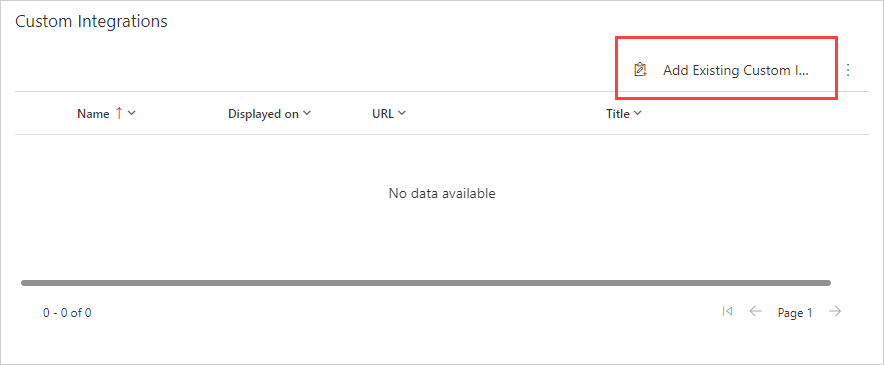
Step 2: Search for and select the desired Custom Integrations.
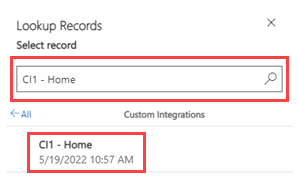
Step 3: Click Add.
Refer to Custom Integration for more information.
Logs
Define the location and limits for log uploads.
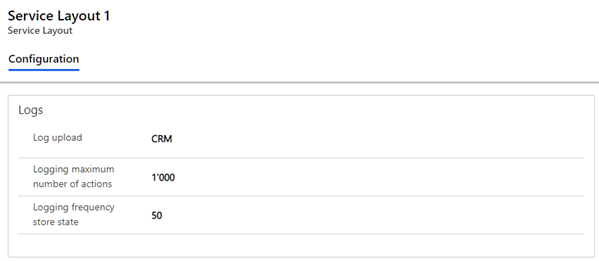
| Name | Description |
|---|---|
| Log upload | Enable/Disable log upload and log storage location. Disabled: no logs can be uploaded CRM: logs are stored on the CRM Default: Disabled |
| Logging maximum number of actions | Defines the number of entries in the log file. Default: 1000 |
| Logging frequency store state | Defines the number of entries that are deleted when the maximum is exceeded. Default: 50 |
Assigned Users
The assigned users list allows Admins to see who is using this Service Layout. They can also add existing users here.

Select one or more users and click "Add".
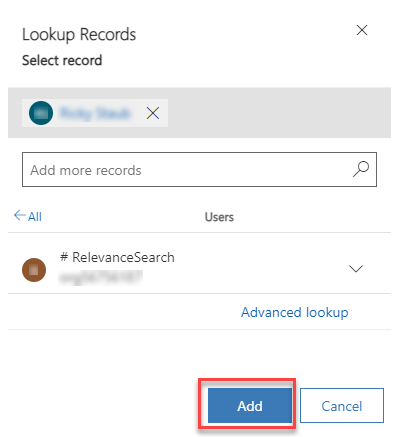
Remove Users
To remove users, you need to select them, click on the three dots, then on "Flow".

Select "Remove Users from Service Layout".

Then accept the popup to remove the selected users.
